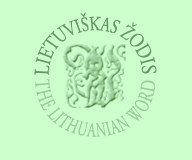- VARPININKAI, a term derived from
the monthly Varpas (The Bell), a clandestine periodical
published in East Prussia (Lithuania Minor) from 1889-1906. The
editors, contributors, publishers, supporters and distributors of the
periodical came to be known as varpininkai, who through their
publication greatly advanced the Lithuanian national movement. In the
beginning, when It first came out, most of the Lithuanian
intelligentsia of that day belonged to varponinkai. While
separated by their personal philosophies, they were united by a single
cause, preserving the individuality of the Lithuanian nation and
releasing it from the yoke of Russian oppression. Later, as the
ideological groups within Lithuanian society began to differentiate
themselves, varpininkai continued to be identified with the
liberal positivist group, which had manifested itself in the first
issues of Varpas and which finally evolved into the Peasant
Populist Union.
- The very first varpininkai were
members of a student society called Lietuva (Lithuania),
founded in Warsaw in 1888. The society's first officers were all
medical students: Jonas Gaidamavicius, president; Juozas Kaukas,
treasurer; and Vincas Kudirka, the future editor of Varpas, secretary.
The latter wrote that the goals of their society could only be
achieved with time: the restoration of the Lithuanian nation as a
separate, self-governing entity, the organization of industry and
trade, founding of schools, libraries, museums, theaters and other
cultural institutions. More specifically varpininkai gave
themselves the task of educating the Lithuanian populace and
strengthening their economic condition. This they sought to accomplish
through the pages of Varpas.
- Yearly meetings were held to discuss
financial and editorial matters pertaining not only to Varpas
but to other periodicals as well. The first such gathering took place
on June 29, 1889; from that time until 1905 there were seventeen
meetings in all. Usually 40-50 people participated, who each year
elected an executive committee, a control committee, and other
committees to deal with specific problems. All of their activity was
carried on secretly, since the Russian administration had forbidden
any type of organized assembly in Lithuania. Kazys Grinius, who served
on the executive committee for 12 years, in his memoirs (1947)
mentions close to 400 individuals who were at one time varpininkai.
Until 1895 the most active members were the students of the Uetuva
society and a sizeable group of Catholic priests and clerics at the
seminary of Seinai, among the latter: Pranciskus Bucys, Aleksandras
Burba, Adomas Grinevicius, Antanas Milukas, Jonas Sutkaitis, Juozas
Tumas-Vaizgantas. When the Catholics withdrew their support, Varpas
found itself in financial peril, but a large group of varpininkai
in Moscow helped to alleviate the problem. The Moscow group included
Juozas Bagdonas, Motiejus Cepas, Kazys Grinius, Feliksas Janusis,
Antanas Krisciukaitis, Petras Leonas, Motiejus Lozoraitis, Baltrus
Matusevicius, Stasys Matulaitis, Jonas Raciunas, and Liudas Vaineikis.
Some of its members with stronger radical and revolutionary views soon
joined the Lithuanian Social Democratic Party (1896).
- At the turn of the century, a
particularly active group emerged in Vilnius. In their midst were
Jonas Bortkevicius, Felicija Bortkeviciene, Gabriele Petkevicaite,
Jurgis Saulys, Jonas and Petras Vileisis, and Povilas Visinskis. Some
of them also became known as the "Twelve Apostles of
Vilnius" because of their outspokenness about the rights of
Lithuanians vis-a-vis the Russian administration and the Polish
ecclesiastical hierarchy. At the Oct. 17, 1902 meeting of varpininkai
it was decided to establish the Lithuanian Democratic Party which was
to work toward a free and independent Lithuania, within its
ethnographic boundaries, governed by a body elected by the people. The
meeting was attended by, among others, Juozas Bagdonas, Jonas
Biliunas, Kazys Grinius, Pranas Masiotas, Gabriele Petkevicaite, Jonas
Vileisis, Povilas Visinskis, and Morta Zauniute. During the Great
Assembly of Vilnius (1905) the younger Democrats formed the Peasant
Union, and at the time of the revolution in Russia (1917) the moderate
varpininkai founded the Lithuanian Socialist Populist
Democratic Party (see Socialist Populists). After the
restoration of the independent Republic of Lithuania, these political
groups merged into the Peasant Populist Union (1922), whose leading
members were Felicija Bortkeviciene, Kazys Grinius, Jonas Makauskis,
Albinas Rimka, Mykolas Slezevicius, Jonas Staugaitis, and Jonas
Vileisis.
-
- Literature:
ENCYCLOPEDIA LITUANICA I-VI, 1970-1978, Boston

